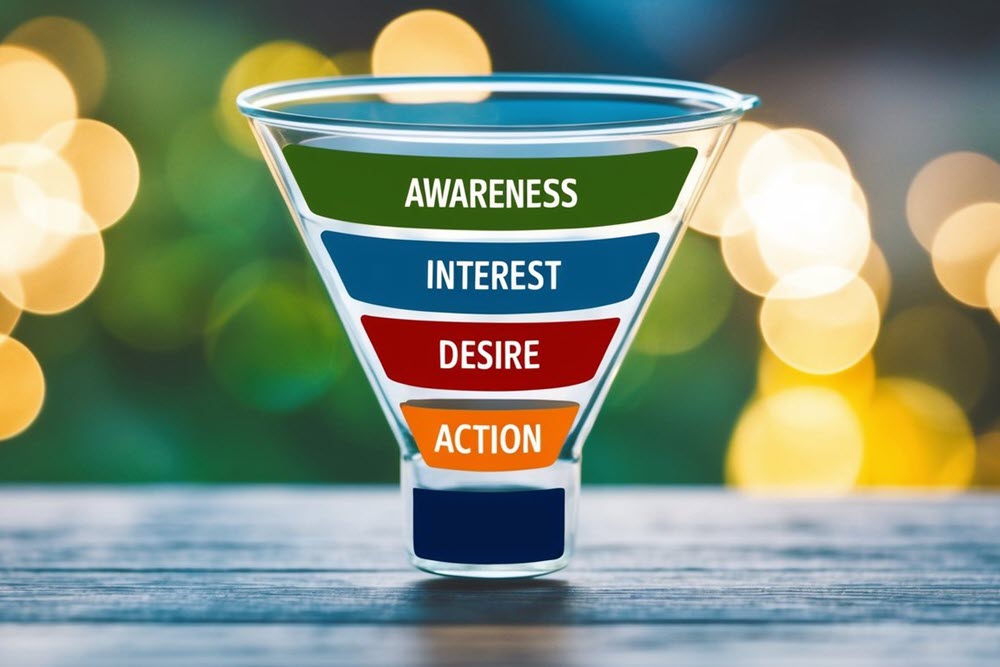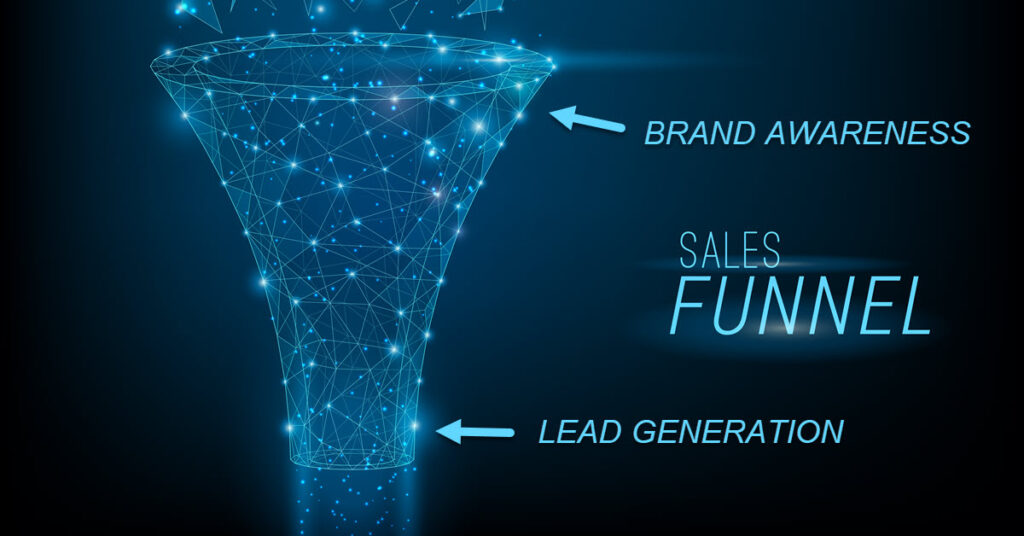What’s the Difference Between the Two?
Demand generation and lead generation are two concepts that sound somewhat similar, but they serve distinct roles in a successful marketing strategy. Demand generation is typically thought of as a Business to Business (B2B) tactic. Most of the clients I work with are local small or small businesses whose target market are consumers (not other businesses). While demand generation is somewhat different for these local businesses than it is for say a B2B software company, similar tactics can and should be applied.

Demand Generation is About Establishing Awareness of Your Products and Services Near the Top of the Sales Funnel – Lead Generation is a Bit Further Down in the Sales Funnel Process
Demand Generation Overview
Demand Generation (also called demand gen) focuses on boosting brand awareness and interest in your products or services. By employing tactics like content marketing and social media campaigns, you create a broader interest in the market. Your goal here is to educate and engage potential customers, cultivating a desire for what you offer.
Demand Generation and B2B Marketing
Frequently used in b2b marketing, a demand generation strategy can be used to educate a prospect about services or products (such as software). Demand generation efforts are used to foster a relationship with a potential buyer in the hopes of transitioning them into a paying customer.
Demand Generation and Business to Consumer (B2C) Marketing
While demand generation is typically thought of as a B2B Marketing strategy, even local businesses like home services pros can participate in demand generation activities. As an example, an appliance repair pro can have lots of DIY articles that show homeowners how to properly clean the burners or grates on their stovetop. They can also use refer readers to articles on their blog that talk about installing an induction stovetop which is much easier to clean and maintain.
Lead Generation Overview
Lead Generation Once a marketing campaign has established awareness and interest and had begun generating demand for your products and services, lead generation activity begins. Both b2c and b2b lead generation follow a similar path.
Generating leads involves collecting information from businesses and consumers who are interested in your products and service offerings. It’s more specific and aims to convert awareness into actionable leads. Strategies like targeted offers and newsletter signups come into play at this point.
While the demand generation campaign sets the stage with educational content and brand storytelling, the lead generation campaign turns interested prospects into potential sales. You encourage prospects to leave their contact details, thereby becoming leads your sales team can pursue.
Demand Generation Tactics
Search Engine Optimization (SEO)
SEO is an inbound marketing technique that involves optimizing your company website to increase its visibility and ranking in organic (non paid) search engine results pages (SERPs). The primary goal of SEO is to improve the quantity and quality of traffic to a website from search engines like Google, Bing, Yahoo and even lesser known search engines like DuckDuckGo.
SEO is a huge topic, but we will focus on the three major components of SEO that apply to demand generation marketing efforts:
Competition Research: Uncover the demand generation strategy of your competitors by using an SEO tool like ahrefs or Semrush. These tools help you to analyze the SEO performance of your competitors. You’ll learn what articles are working best, what keywords and phrases that they’re ranking for, the amount of traffic the competition is receiving. From this data, you’ll be able to focus on your own SEO strategy for b2b demand generation.
Content Marketing: Your organization should create valuable, relevant content (blog posts, whitepapers, e-books, videos) to attract and engage your target audience. Bonus points if your content contains actionable information that your prospects can use to improve their business.
Technical SEO: Proper technical SEO helps to increase the chances that your content can be easily found when prospects conduct searches for topics related to your services on Google. Optimize your website and content to rank higher in search engine results, increasing visibility to potential customers.
Pay Per Click Advertising (PPC Ads)
PPC Search Ads (For both B2B and B2C)
PPC Advertising can be highly effective no matter who your target customer is. PPC search ads target potential clients at the exact moment they’re actively searching for relevant products or services that you offer. These ads appear prominently at the top of the search engine results page which allows you to capture the attention of decision makers who are already in a business mindset and potentially in the buying phase.
PPC Search ads also offer precise control over budget, targeting, and messaging, allowing for continuous optimization based on performance data. You’ll also receive a lot of helpful marketing data when using PPC Ads. You’ll know what ad messaging combinations are best at producing leads for your organization.
Social Media PPC Advertising (Best for B2C)
Social Media Advertising on Platforms like Yelp, Facebook, and NextDoor are best suited towards B2C advertising. Local businesses like home services professionals should consider social media advertising when trying to reach prospects in their service area. These platforms all have deep demographic data to target customers by criteria such as location, interests,
LinkedIn PPC Advertising (Best for B2B)
LinkedIn Ads can be effective when trying to reach B2B prospects. It has sophisticated targeting that allows you to show ads to a potential customer based on specific job titles, industries, company sizes, and other criteria. The result is that you can get your marketing message in front of decision makers who may be interested in your offerings.
Social Media Marketing (Best for B2B)
Consider having a dedicated social media manager to engage with your target audience on relevant social platforms like LinkedIn, Facebook, or even Twitter. Having a strong, dynamic social media presence can build brand awareness and cultivate relationships with potential future customers.
Webinars / Virtual Events (Best for B2B Software or Products)
Host online events to showcase your expertise and engage with potential customers. Webinars are particularly effective for products like software where you can easily demonstrate the power of your offerings in real time and answer customer questions. A major webinar bonus is that when recorded, webinars can be repurposed and used on your website and your YouTube channel.
Free Trials or Demos (Best for B2B Software)
If you’re a software company, offer potential customers a chance to experience your product or service firsthand for a limited time. Software functionality and features are very abstract unless a user gets to actually try the software on their own. There’s no better way to convey how awesome your product is than by giving your potential customers the keys and let them take the software for a spin.
Account Based Marketing (Best for High Value B2B Prospects):
Account based marketing involves devoting intense focus on high-value target accounts with personalized marketing efforts. Instead of engaging in broad based tactics like paid search advertising, you identify your targeted customers in advance and gear marketing activities specifically around those customers. Note that this is a resource intensive B2B tactic that should only be employed when you are focused on a few high value accounts.
Referral Programs (Best for B2C, Also Works for B2B)
Referral programs are incentive based programs. You’ll provide an incentive for existing customers of your products or services to refer others to your company. The great thing about referrals is that the new referrals are likely to already have a high opinion of your product or service – because they were referred by a source they trust.
For B2C referral programs customers may receive an incentive like free months of your service, or free products when they refer others who become new customers. B2B referral programs may also offer discount incentives, but they can also be more involved and even formally structured in a contract.
Trade Shows and Industry Events (Best for B2B)
Not all demand generation needs to be done online or on the phone. Meeting prospects face to face can be extremely effective to raise awareness of your company offerings. Consider participating in or sponsoring events where your target audience gathers.
Lead Generation in Depth
With demand generation and other tactics, the goal is to make customers aware of your company and its offerings. The goal of your lead generation strategy is to get the information of interested customers to consent to receiving more marketing information from your company.
Lead Generation Tactics
Many of the effective Demand Generation strategy ideas mentioned above can also be used as part of lead generation campaigns.
Lead Generation on Your Website
Here, we discuss lead generation tactics that are specific to your company’s website.
- Lead Magnets: Offer valuable resources (e.g., e-books, templates) as a lead magnet in exchange for contact information from a potential lead.
- Landing Pages: Create optimized landing pages for specific offers or campaigns to capture lead information. You will send paid search traffic to these landing pages.
- Live Chat from Trained Sales Professionals: Offer chat on your website to quickly and properly answer any customer questions. While AI powered chatbots are all the rage, many of them just aren’t all that smart and can annoy and cause customers to bounce from your website.
- Call to Action: A clear call to action that is easily visible on your website is an essential lead generation tactic that helps to increase conversions.
- Lead Capture Forms: Your company should offer both a phone number and lead capture forms which make it easy to contact your company. These forms should be very short to encourage prospects to complete and submit the forms. The lead capture form should not be used to qualify leads.
Lead Generation Processing: CRM and Lead Scoring
If you’re capturing leads, you need a way to store those leads and track their progress through your sales funnel. Your organization should procure a CRM to manage these leads. A CRM with lead scoring can help you to prioritize which leads in your sales pipeline should receive the most attention.
Nurturing Leads Towards Conversion
Nurturing leads is a vital component in moving them through the sales funnel to conversion. This process leverages strategic communication and monitoring to build relationships and prepare leads for the buying decision.
The Role of Email Marketing in Lead Nurturing
You use email marketing to provide leads with valuable content. Think of it as a direct line to their inbox, where you can send targeted messages that align with their stage in the sales funnel. Regular newsletters keep your brand top of mind, while personalized emails based on lead behavior offer a custom touchpoint.
Make sure that you only reach out to leads who have explicitly opted in to receiving your emails.
- Newsletters: Send these monthly to educate and engage.
- Targeted Emails: Craft these based on user actions or milestones as they migrate through your sales funnel
Demand Gen and Lead Gen Metrics: Measuring Effectiveness
To gauge the success of your demand and lead generation efforts, focus on key performance indicators (KPIs). This approach ensures you track progress towards your marketing goals.
Demand Generation Metrics:
- Website Traffic: Assess the volume and sources to understand the reach of your content. For large organizations, Google Analytics is a popular choice. Smaller organizations may wish to consider lighter weight and much easier to use analytics packages like Plausible.io.
- Engagement: Track likes, shares, and comments across various channels to measure audience interest.
- Brand Awareness: Use surveys and mentions to gauge recognition in your target market.
Lead Generation Metrics:
- Website Behavior Software: Tools like Hotjar help you to track user behavior while on your website. This helps you to identify potential issues that may be preventing a prospect from converting and becoming a qualified lead.
- Conversion Rates: Measure the percentage of visitors who take a desired action on your website.
- Sales Funnel Progression: Track how leads move through stages from initial contact to sale.


